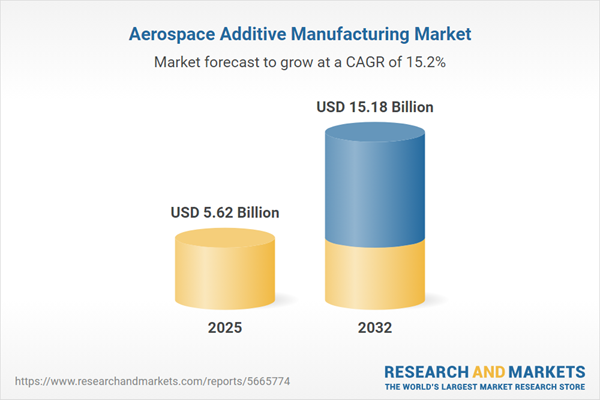Speak directly to the analyst to clarify any post sales queries you may have.
The aerospace additive manufacturing market is rapidly redefining production capabilities across aviation, defense, and space segments. As new digital workflows and advanced materials alter manufacturing landscapes, decision-makers must remain alert to shifting opportunities, emerging risks, and competitive strategies within this technologically disruptive sector.
Market Snapshot: Aerospace Additive Manufacturing Market Growth and Outlook
The aerospace additive manufacturing market grew from USD 4.89 billion in 2024 to USD 5.62 billion in 2025. Projected to grow at a CAGR of 15.20%, the market is expected to reach USD 15.18 billion by 2032.
Heightened commercial and defense demand, together with evolving fuel-efficiency requirements, is accelerating market maturity. Gains in digital monitoring, adaptive process control, and high-performance materials are establishing additive manufacturing as an integral tool for next-generation aerospace production.Scope & Segmentation
- Process Technologies: Binder jetting (metal, sand), directed energy deposition (electron beam, laser), material extrusion (fused filament fabrication, large-format extrusion), powder bed fusion (electron beam, laser), vat photopolymerization (digital light processing, stereolithography).
- Material Types: Composite materials (carbon fiber reinforced, glass fiber reinforced), metal alloys (aluminum, nickel, titanium), polymers (thermoplastics, thermosets).
- Applications: Airframe components (functional, structural), engine components (combustion chamber, turbine blades), interior components (cabins, seating), tooling (jigs and fixtures, molds).
- End Uses: Commercial aircraft, military aircraft, spacecraft, unmanned aerial vehicles.
- Service Types: Additive manufacturing services (production, prototyping) and equipment sales (new, refurbished).
- Regional Coverage: Americas (United States, Canada, Mexico, Brazil, Argentina, Chile, Colombia, Peru), Europe, Middle East, and Africa (UK, Germany, France, Russia, Italy, Spain, Netherlands, Sweden, Poland, Switzerland, UAE, Saudi Arabia, Qatar, Turkey, Israel, South Africa, Nigeria, Egypt, Kenya), Asia-Pacific (China, India, Japan, Australia, South Korea, Indonesia, Thailand, Malaysia, Singapore, Taiwan).
- Companies Profiled: 3D Systems Corporation, Stratasys Ltd., EOS GmbH, General Electric Company, HP Inc., SLM Solutions GmbH, Materialise NV, Renishaw plc, ExOne Company, Nano Dimension Ltd.
Key Takeaways for Senior Decision-Makers
- Additive manufacturing is shifting from its roots in prototyping to full-scale aerospace production, enabling intricate geometries and lightweight structures previously unattainable through conventional processes.
- Integrated digital monitoring and adaptive controls are strengthening process reliability, while advanced alloys and composite systems are supporting a diverse range of flight-critical and customized components.
- Collaborative efforts between equipment manufacturers, material suppliers, and research organizations are driving faster certification cycles and fueling continuous innovation in both process and material development.
- Regional expansion includes North American leadership in system innovation, Western Europe’s standardization initiatives, emerging clusters in Mexico and the Middle East, and Asia-Pacific’s focus on powder capacity and integrated production programs.
- Strategic investments in workforce upskilling, digital twins, and simulation tools are vital to bridge current capability gaps as industry standards and regulatory requirements continue to evolve.
Tariff Impact: Navigating United States Policy Shifts in 2025
Recent tariffs enacted by the United States on imported powders and specialized components have changed material cost dynamics. In response, leading aerospace organizations are investing in domestic feedstock production and forming alliances with specialty chemical firms to safeguard supply continuity. Operational strategies now emphasize localized sourcing and advanced traceability, while some players turn cost headwinds into supply chain and production resilience advantages.
Methodology & Data Sources
This research integrates primary interviews with aerospace executives, procurement leaders, and technical specialists, capturing lived insights on evolving strategies and operational realities. Rigorous secondary analysis of technical publications, peer-reviewed journals, and industry filings complements these perspectives, while expert consultations validate emerging process, certification, and material qualification trends.
Why This Report Matters
- Enable strategic planning by understanding how new process technologies, regulatory trends, and regional dynamics influence the aerospace additive manufacturing landscape.
- Support informed investment and procurement decisions by mapping ecosystem partnerships, material advances, and service capabilities.
- Anticipate supply chain risks and capitalize on competitive opportunities arising from shifting policy and certification frameworks.
Conclusion
The aerospace additive manufacturing sector is progressing toward greater operational agility, innovation, and integration across business models. Leaders who align technical strategy with evolving regulatory, regional, and market dynamics are best positioned to drive sustainable growth and competitive differentiation.
Additional Product Information:
- Purchase of this report includes 1 year online access with quarterly updates.
- This report can be updated on request. Please contact our Customer Experience team using the Ask a Question widget on our website.
Table of Contents
3. Executive Summary
4. Market Overview
7. Cumulative Impact of Artificial Intelligence 2025
Companies Mentioned
The companies profiled in this Aerospace Additive Manufacturing market report include:- 3D Systems Corporation
- Stratasys Ltd.
- EOS GmbH
- General Electric Company
- HP Inc.
- SLM Solutions GmbH
- Materialise NV
- Renishaw plc
- ExOne Company
- Nano Dimension Ltd.
Table Information
| Report Attribute | Details |
|---|---|
| No. of Pages | 199 |
| Published | November 2025 |
| Forecast Period | 2025 - 2032 |
| Estimated Market Value ( USD | $ 5.62 Billion |
| Forecasted Market Value ( USD | $ 15.18 Billion |
| Compound Annual Growth Rate | 15.2% |
| Regions Covered | Global |
| No. of Companies Mentioned | 11 |









